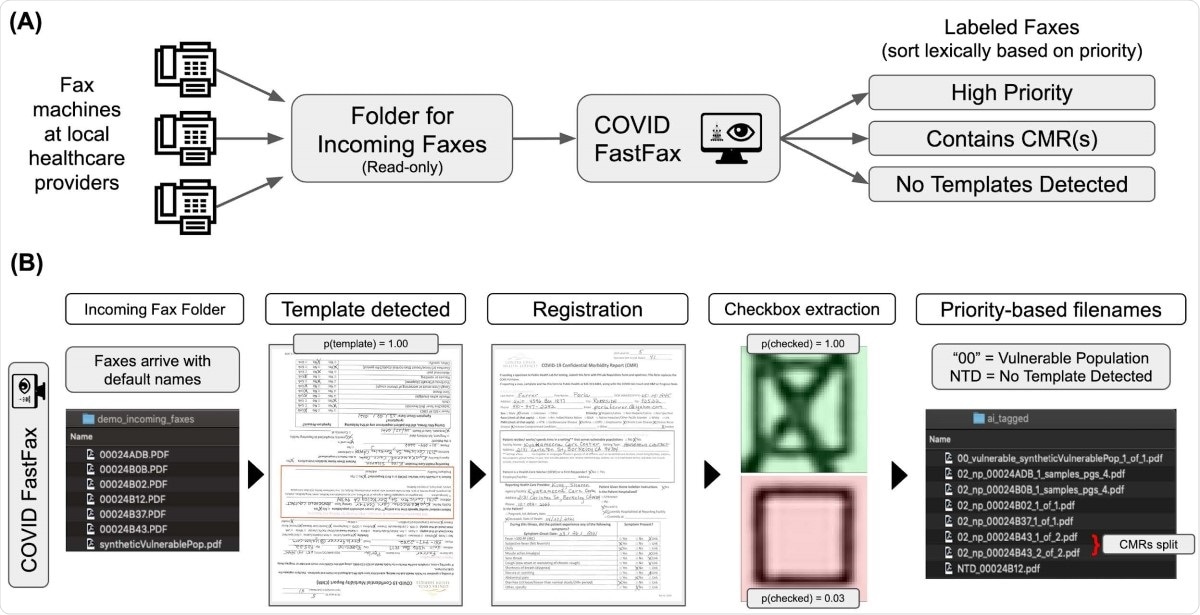A year on since the coronavirus disease 2019 (COVID-19) pandemic first emerged, many lessons have been learned about the dynamics of its spread. Immediate isolation and contact tracing has played a pivotal role in containment strategies.
Though some countries have efficiently "flattened the curve" and effectively prevented sharp surges of COVID-19 cases, many still grapple with the pandemic. To date, there are more than 76.41 million cases and over 1.68 million deaths worldwide.
Having a cost-effective method of triaging patients and identifying possible cases is crucial in fighting against the severe acute respiratory syndrome coronavirus 2 (SARS-CoV-2), the virus that causes COVID-19.
A team of US-based researchers at Stanford University and Contra Costa Health Services have developed an artificial intelligence (AI)-based system that can identify and triage handwritten faxed COVID-19 forms in real-time.

Overview of COVID Fast Fax System. (A) Shows overall CMR fax workflow, where local healthcare providers faxes are received by a holding folder that maintains the original faxes unaltered. These fax documents are then ingested by the COVID Fast Fax system yielding prioritized reports based on priority status and likelihood of containing a CMR. (B) Schematic showing the COVID Fast Fax internal system process. An ingested PDF is split into pages and each page is processed separately. First, a neural network classifies each page as to whether it contains one of the CMR templates. Second, if a template is detected, the page is registered to the relevant known templates and a match is confirmed. If a match is confirmed, then checkboxes are extracted and classified as checked or unchecked. This process results in metadata on triage priority, the total number of CMRs, and the location of CMRs within the original documents.

 *Important notice: medRxiv publishes preliminary scientific reports that are not peer-reviewed and, therefore, should not be regarded as conclusive, guide clinical practice/health-related behavior, or treated as established information.
*Important notice: medRxiv publishes preliminary scientific reports that are not peer-reviewed and, therefore, should not be regarded as conclusive, guide clinical practice/health-related behavior, or treated as established information.
COVID-19 tracking
Though there are many innovative ways to send information nowadays, many health departments accept COVID-19 reports and cases via phone, email, physical mail, and fax. Aside from being tedious, it can lead to duplication, lost information, or sending the wrong health department's data.
It was reported that the COVID-19 office tracking for Austin, Texas, receives around 1,000 faxes per day, with some records duplicated or missing. It takes approximately 11 days for all the information from a COVID-19 test to manually enter the system.
Amid the coronavirus pandemic, many health departments receive hundreds or thousands of COVID-19 case reports per day. Many of these arrive via faxed handwritten forms that can be intermingled with other faxes, making it hard to identify the highest priority for monitoring.
The scale and speed of the current pandemic, which is now in its second wave, seems to overwhelm governments and healthcare systems. Hence, finding a way to accurately and rapidly send and receive information and case updates is crucial.
Fast fax
The study, which appeared on the pre-print medRxiv* server, presents an AI-based system that can identify and triage handwritten faxed COVID-19 forms.
The team used a local LHD fax line for the study. They received the faxes digitally and stored them as PDF files on a network folder.
The system has two models. The first one works by extracting data from Confidential Morbidity Report (CMR) forms by developing a model to recognize which pages from the fax were CMR forms from other documents. Meanwhile, the second model extracted information from the case reports.
The researchers presented a system for the real-time triaging of COVID-19 case reports received through fax. They found that the system can handle five different report templates, which were selected based on a sample of 186 reports from incoming faxes for over two days.
The system scanned 1,224 faxes received in real-time via the LHD fax line over 14 days. Overall, the system had a good performance on the CMR recognition and case acuity triage tasks.
For document classification, the system detected a precision of 0.98 in terms of CMR. Among all the received COVID-19 faxes, the system identified high priority cases with a specificity of 0.87.
The team also reported that the system captured 49 of the 59 high acuity reports, with limited false positives. It has also identified the true positives quickly and reprioritized them to the top of the queue, reducing the time to identify and enabling a more effective public health response.
The team started a pilot deployment of the system at a single LHD, and the initial response to the system has been positive. The system has successfully alerted the team to several high-acuity cases, which would not have otherwise been processed until over 20 hours later.
Future work will involve improving the performance of existing models, the ability of the system to generalize to new templates, as well as developing a more full-featured optical character recognition pipeline to assist with data extraction and data entry, tasks that currently consume a significant amount of LHD staff time," the team explained.
Using technology, specifically AI-based systems, can help in the timely and fast reporting of COVID-19 cases. This way, positive cases are immediately isolated and treated.

 *Important notice: medRxiv publishes preliminary scientific reports that are not peer-reviewed and, therefore, should not be regarded as conclusive, guide clinical practice/health-related behavior, or treated as established information.
*Important notice: medRxiv publishes preliminary scientific reports that are not peer-reviewed and, therefore, should not be regarded as conclusive, guide clinical practice/health-related behavior, or treated as established information.
Source:
Journal reference:
- Preliminary scientific report.
Lavertu, A., Stribling, A., White, M., McInnes, G., Altman, R., Pramanik, R., and Kaushal, A. (2020). Covid Fast Fax: A system for real-time triage of Covid-19 case report faxes. medRxiv. doi: https://doi.org/10.1101/2020.12.15.20248256 https://www.medrxiv.org/content/10.1101/2020.12.15.20248256v1